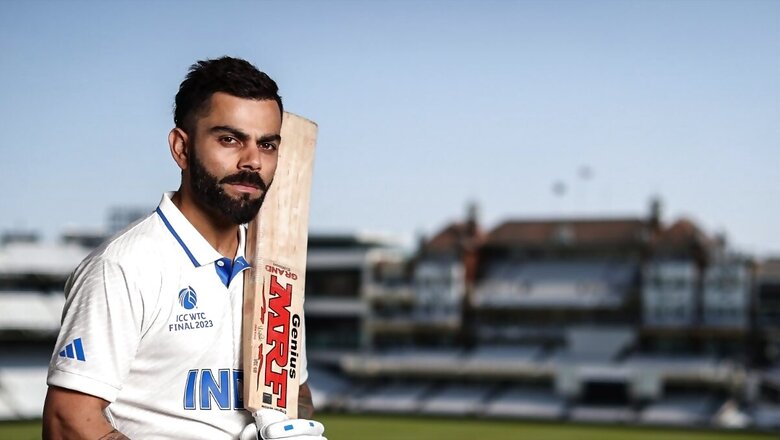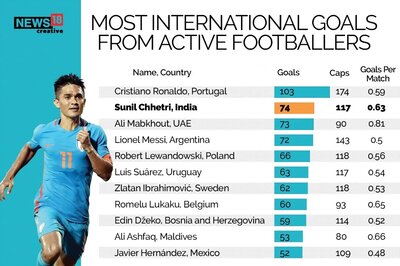
views
The bowler takes position, waits for the umpire’s signal and the batsman’s nod. The crowd is cheering for their favourite batsman to send the full toss straight outside the stadium in one swing. There’s music in the background, drums rolling and fans screaming God’s name.
That song could apply to any of the matches in the Indian Premier League or the ICC World Cup. The difference is — as Boria Majumdar points out — unlike the World Cup, where things can go wrong on occasions and the popular teams, especially India, could make an early exit, an Indian team wins every night in the IPL.
Over the last few years, India has done exceedingly well in all formats of cricket to emerge as one of the strongest teams. However, its period of dominance has coincided with the sharp decline in the standard of the West Indies and Sri Lanka teams.
The Indian team’s fortunes soared somewhere in the early 2000s when they started winning more matches and tournaments outside Asia. And with the advent of IPL in 2008, several domestic cricketers got a boost in confidence and skill with greater exposure to some of the best cricketers in the world.
However, in the last 10 years, there have been only four teams, globally, that have remained potent — India, Australia, England and New Zealand. While the South African team is still trying to resurrect its fortunes, West Indies, Zimbabwe and Sri Lanka have been in a terminal tailspin of inconsistent performances. As status stands, all these teams will be playing the qualifiers to get a ticket to play in the ICC Men’s Cricket World Cup 2023.
Since 2015, West Indies, Zimbabwe and Sri Lanka have a winning percentage between 27 to 34% in all formats of cricket, and these numbers fall sharply when you take away statistics of matches against stronger teams. This stark imbalance among cricketing teams has dented the overall quality of cricket.
The Rise & Fall of Titans
Once considered one of the most domineering and destructive forces in world cricket, the standard of West Indies cricket began its downfall in the late 1990s, after Curtly Ambrose and Courtney Walsh retired. The team kept finding decent batsmen but their fast bowling quality — once they had six world-class pacers jostling for a place in the playing XI — went awry.
Sri Lanka, on the other hand, became a force to reckon with between 1995 and 2011 — the team won the World Cup in 1996 and a host of other ODI tournaments. With players such as Mahela Jayawardene, Kumar Sangakkara, Sanath Jayasuriya and Muttiah Muralitharan retiring, the team’s stature and performance have slumped drastically.
The Dark Horse in Play
Zimbabwe, too, was a robust unit in the late 1990s and early 2000s. The likes of Andy Flower, Neil Johnson, Heath Streak, Grant Flower and Alastair Campbell pushed the team to the forefront and they qualified to the Super Six stage both in the 1999 and 2003 ICC World Cups. The team had also won a Test series against Pakistan around the same time. However, that spark wore off post-2003 due to the political turmoil in the country.
Games of the yesteryear are fondly remembered and cherished because all the top nine teams were fairly strong and competitive. None could be taken lightly and on a day, every team had the ammunition to emerge victorious. As a result, the quality of cricket on display was superlative.
The popularity of cricket, however, is still limited in a handful of countries. Although India, with its 1.4 billion population, accounts for most of the viewership, the sport still finds it tough to cut into the viewership of other high-profile games such as football, hockey or even tennis.
A great example of a sport’s revival could be the Pro Kabaddi League. It was almost a dying game, with a few strands here and there — maybe in schools — until PKL kicked off in 2014.
Money, A Factor Indeed In Revival
Let’s get back to the Indian team. When it won the 1983 ICC World Cup, the cash-strapped BCCI did not have much money to reward its heroes. The then treasurer of the association, Jagmohan Dalmiya, is often given a lot of credit for the globalisation of cricket in India.
As fate had it, it was Dalmiya who, along with the then BCCI president IS Bindra, brought the World Cup out of England into India. Again, it was him who the BCCI should be thankful to, for filling its coffers by selling the broadcast rights to a private broadcaster for the first time.
It may also be noted that cricket’s popularity is directly proportional to the amount of funding a team receives. For example, take the 2003 World Cup semi-final between India and Kenya. How did a team, so close to the World Cup finals at one point, stoop down to a level where the sight of cricket itself seems impossible now!
Well, the internet seems to believe it is the lack of adequate funding at the grassroots level to increase popularity and also not enough encouragement (monetary) for the teams to tour other nations.
A foray into the Olympics also has been talked about for a long time. This is where the revival of the earlier talked about teams comes into play. Additionally, Zimbabwe’s comeback to the arena could work wonders for the other 18 teams from the continent as well.
The ICC has recommended six-team T20 events for both men and women to the 2028 Los Angeles Olympic Games organizing committee. Cricket is competing with eight sports — baseball/softball, flag football, lacrosse, break dancing, karate, kickboxing, squash and motorsport — to make the cut for the 2028 Olympics.
The Olympic charter indicates that in order to be accepted, a sport must be widely practised by men in at least 75 countries and on four continents and by women in no fewer than 40 countries and on three continents. It may be noted that the ICC has a total of 106 members, of which only 12 are full-time. Can the likes of the US, Ireland, Scotland, and Netherlands expand this elite club, and make cricket competitive? Or West India, Sri Lanka & Zimbabwe will chart a comeback? This only time will tell. However, for now, all eyes are on the upcoming World Cup later this year.
Road to the Cup
- The 2023 ICC Men’s Cricket World Cup Qualifier will be played in Zimbabwe between June 18 and July 9
- Zimbabwe, Sri Lanka, West Indies will play each other and seven other teams in the qualifier
- Two spots will be up for grabs in the World Cup
- Teams that have already qualified are New Zealand, England, Bangladesh, India (host), Pakistan, Australia, Afghanistan and South Africa
(Authored by Aman Dhall. The author is a sports scholar, an angel investor & founder of PR & Comms Tech Startup, CommsCredible. Views expressed here are personal.)




















Comments
0 comment